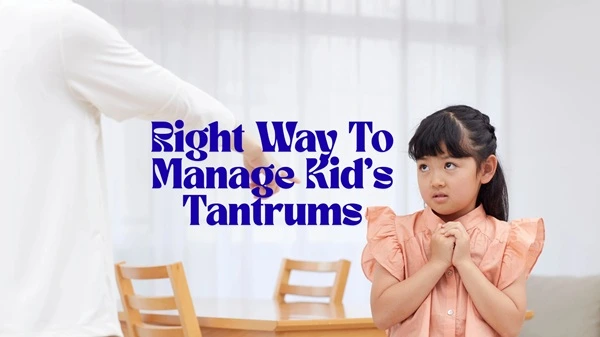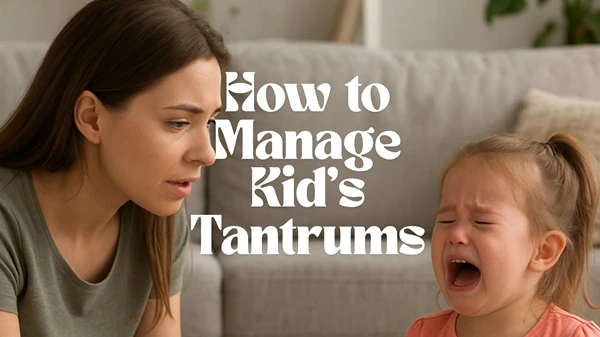Parenting is often described as a journey filled with love, laughter, and countless cherished moments. But let’s be honest, every parent also faces the stormy side of raising kids. The sudden outbursts in a supermarket aisle, the ear piercing screams at bedtime, or the meltdown when you say “no” to another piece of candy. Yes, we’re talking about kids’ tantrums.
If you’ve ever felt helpless during one of these emotional whirlwinds, you’re not alone. Tantrums are a universal parenting challenge, but here’s the good news, they are a completely normal part of childhood development. More importantly, with the right approach, parents can not only manage tantrums effectively but also use them as opportunities to teach children emotional regulation, patience, and empathy.
In this comprehensive guide, we’ll dive deep into what tantrums really mean, why they happen and how managing kid tantrums calmly and constructively can be the right way.
Understanding Tantrums: Why Do Kids Have Them?
Before we talk about managing kid tantrums, it’s important to understand why they happen. A tantrum is a child’s way of expressing overwhelming feelings they cannot yet process or communicate effectively.
Common triggers include:
- Frustration: A toddler struggling with a toy that won’t fit together.
- Fatigue: A meltdown at bedtime or after a long day.
- Hunger: The classic pre meal crankiness.
- Attention seeking: When kids want your focus and aren’t getting it.
- Boundary testing: Saying “no” and seeing how far they can push.
For young children, tantrums are less about manipulation and more about a lack of emotional skills. They don’t yet know how to say, “I’m upset,” “I need help,” or “I feel ignored.” Instead, their emotions spill over in the form of crying, screaming, kicking or refusing to cooperate.
Types of Tantrums Parents Encounter
Not all kid tantrums are the same. Recognizing the type can help parents respond better:
- Frustration Tantrums: When a child can’t achieve something (like tying shoelaces).
- Attention Tantrums: When kids act out to grab parental attention.
- Overstimulation Tantrums: Too much noise, activity, or social interaction.
- Demand Tantrums: When denied something they desperately want.
- Fatigue Tantrums: Usually towards the end of the day or after skipping naps.

How Parents Should Handle Tantrums
Here’s the heart of the topic, effective strategies parents can use to managing kid tantrums calmly and wisely.
1. Stay Calm Yourself
Children feed off your energy. If you shout back, the tantrum will only escalate. Take a deep breath, keep your voice steady, and model the calm behavior you want your child to learn.
2. Acknowledge Their Feelings
Instead of dismissing the tantrum with “Stop crying” or “Don’t be silly,” acknowledge what your child is going through. For example:
- “I know you’re upset because we can’t buy that toy.”
- “You’re frustrated because the puzzle piece won’t fit.”
This validates their emotions and teaches them that feelings are normal.
3. Offer Choices
Kids often tantrum because they feel powerless. Offering simple choices gives them a sense of control. For instance:
- “Do you want apple slices or a banana?”
- “Do you want to wear the red shirt or the blue one?”
4. Set Clear Boundaries
Consistency is key. If you’ve said “no” to candy before dinner, stick to it. Giving in to avoid embarrassment in public might stop the tantrum temporarily but reinforces the behavior long term.
5. Use Distraction Wisely
Sometimes redirecting attention works wonders. If your child is crying for a toy, distract them with a fun activity: “Let’s race to the car!”
6. Maintain Routines
Kids thrive on predictability. Regular meal times, naps, and bedtime reduce the chances of fatigue driven meltdowns.
7. Teach Emotional Words
Encourage your child to express feelings in words:
- “I feel angry.”
- “I’m sad.”
- “I need help.”
The more vocabulary they have, the less they’ll rely on tantrums to express themselves.
What NOT to Do During a Tantrum
Sometimes, well meaning parents unintentionally worsen tantrums. Avoid these mistakes:
- Don’t Bribe Constantly: Offering candy or toys every time they cry teaches them to tantrum for rewards.
- Don’t Ignore Safety: If a tantrum turns physical (hitting, throwing objects), step in to ensure safety.
- Don’t Shame Them: Phrases like “You’re embarrassing me” or “Big kids don’t cry” can damage self esteem.
- Don’t Lose Your Temper: It shows kids that yelling is an acceptable way to handle frustration.
Helping Kids Understand Their Emotions
Managing Kid tantrums is not just about stopping the behavior in the moment, it’s about teaching long term emotional regulation.
- Storytelling: Use bedtime stories to talk about feelings (e.g., “Ajay was sad when he lost his toy, but he asked for help”).
- Emotion Charts: Show pictures of happy, sad, angry, tired faces. Ask, “Which one are you feeling right now?”
- Role Play: Act out scenarios where they practice calm responses.
- Praise Positive Behavior: When your child calms down without a meltdown, acknowledge it: “I’m proud you used your words instead of crying.”
Age-Wise Approach to Tantrums
Toddlers (1–3 years)
- Keep instructions short and simple.
- Redirect attention quickly.
- Hug or hold them gently to reassure.
Preschoolers (3–5 years)
- Encourage verbal expression.
- Offer simple choices.
- Teach short calming strategies like deep breaths.
School Age Kids (6–10 years)
- Explain consequences clearly.
- Involve them in problem solving: “What could we do differently next time?”
- Encourage journaling or drawing feelings.
Long-Term Strategies to Reduce Tantrums
- Build Emotional Intelligence: Teach kids to recognize and name feelings.
- Encourage Independence: Let them try small tasks themselves.
- Model Calmness: Show how you manage your own stress.
- Positive Reinforcement: Reward calm communication with praise or extra playtime.
- Consistent Sleep & Nutrition: Prevent meltdowns caused by tiredness or hunger.
When Should Parents Worry About Tantrums?
Tantrums are normal, but seek professional help if:
- They happen very frequently and intensely.
- Your child hurts themselves or others.
- Tantrums continue beyond age 7–8 without improvement.
- They interfere with school, friendships, or family life.
In such cases, consulting a pediatrician or child psychologist can help identify deeper issues such as anxiety, ADHD or sensory processing difficulties.
Practical Tips Parents Can Use Today
- Carry healthy snacks when going out to prevent hunger meltdowns.
- Prepare kids for transitions e.g., “We’ll leave the park in 5 minutes”.
- Use calm corners at home—a safe space with toys or books where kids can cool off.
- Practice mindfulness together—teach simple breathing exercises.
- Stay connected emotionally—daily cuddles, bedtime talks, and quality time reduce attention-seeking tantrums.
Final Thoughts
Every tantrum feels like a storm, but remember, storms eventually pass, and they leave behind a clearer sky. Kids’ tantrums are not signs of “bad behavior” but rather expressions of overwhelming feelings. With patience, consistency and empathy, parents can guide children through these emotional outbursts and teach them valuable life skills in the process.
The next time your child has a meltdown, see it as an opportunity, not just to calm them down, but to help them grow. Because when handled with love and care, tantrums can become stepping stones to raising emotionally intelligent, resilient, and confident children.
Frequently Asked Questions (FAQs) About Managing Kids’ Tantrums
1. Why do kids throw tantrums?
Kids throw tantrums because they don’t yet have the emotional maturity or vocabulary to express frustration, anger, or disappointment. It’s their way of communicating overwhelming feelings like hunger, tiredness, or the desire for attention.
2. What should I do when my child throws a tantrum in public?
Stay calm and avoid feeling embarrassed by others’ stares. Acknowledge your child’s feelings in a calm voice, set clear boundaries (“We’re not buying that toy today”), and remove them from the overstimulating environment if needed. Consistency is key, even in public.
3. Should I ignore my child’s tantrum?
It depends on the situation. If your child is safe and the tantrum is purely for attention, calmly ignoring can be effective. However, never ignore if your child is in danger of hurting themselves or others. In that case, step in gently but firmly.
4. How can I prevent tantrums before they start?
Prevention is possible!
- Stick to regular routines for meals and sleep.
- Give advance warnings before transitions (“Five more minutes of play before we leave”).
- Offer limited choices so kids feel in control.
- Keep snacks handy to avoid hunger driven meltdowns.
5. Is it okay to punish kids for tantrums?
Punishment usually doesn’t work for tantrums. Instead, focus on teaching calm alternatives. Use positive reinforcement when they express emotions with words. Gentle consequences can be set if tantrums turn aggressive (e.g., losing screen time for hitting).
6. At what age do tantrums usually stop?
Most children start having tantrums between ages 1 and 3, with the frequency peaking around toddlerhood. By the time they’re 6–7 years old, tantrums usually decrease as they learn better communication and self control skills. If tantrums persist beyond this age, seek guidance from a pediatrician.
7. When should I worry about my child’s tantrums?
You should consult a professional if tantrums are extremely frequent, last very long, involve aggression, or interfere with school and social life. This could signal an underlying issue such as anxiety, ADHD, or sensory processing difficulties.

Hi, I’m Prashant Jain — a curious soul, storyteller, and content creator at heart.I’ve always been drawn to the world of entertainment, travel, sports, health & lifestyle — not just as a writer, but as someone who genuinely lives these experiences. Whether I’m binge-watching the latest OTT series, exploring offbeat spiritual destinations in India, or diving deep into wellness routines and cricket match insights, I love sharing what I discover with like-minded readers.
PopNewsBlend is my way of blending personal journeys with meaningful stories — ones that inform, inspire, and keep you ahead of the curve. Everything I write comes from real observations, hands-on experiences, and a deep passion for understanding the world around us.
Discover more from Popnewsblend
Subscribe to get the latest posts sent to your email.







